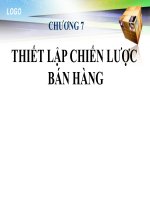Cẩm nang chiến lược bán hàng
Bạn đang xem bản rút gọn của tài liệu. Xem và tải ngay bản đầy đủ của tài liệu tại đây (1.17 MB, 38 trang )
Part I
THE BIG PICTURE
Chapter 2:
Strategy and Sales
Program Planning
The natural progression
How to make sales force and sales
program decision
Business
Strategy
Marketing
Strategy
Go-to-Market
Strategy
Supply Chain
Management (SCM)
Customer
Relationship
Management (CRM)
LEVEL 2
Strategy
Implementation
Decisions
Product Development
Management
(PDM)
LEVEL 1
Top
Management
Decisions
Figure 2-1 The Sales Force Decision Sequence
LEVEL 3
Sales Force
Program
Decisions
Account Relationship
Strategy
Business Strategy
Figure 2-2
: Factors Influencing Strategic Management
Distinct competencies
Marketing
Financial
Technology
Information
Environmental constraints
Legal & regulatory
Demographics
Economic Conditions
Technology
Competitive conditions
Sociocultural factors
Strategic Management
Planning
Resources
Financial
R&D
Personnel
Brand Equity
Production
Firm’s history
management culture
Marketing Strategy
Figure 2-3
: Hierarchy of Sales Objectives
Corporate goals
Maximize shareholder wealth
Business unit objectives
12% revenue growth
Grow pre-tax profits by 18%
Marketing objectives
Increase product A’s market share by 2 points
Grow contributions after sales & marketing by 20%
Sales department objectives
Achieve sales revenue of $210 million
Grow contributions after sales expenses by 25%
Sales district objective
Achieve sales revenue of $10.5 million in product A
Obtain $7 million contributions after direct selling
Salesperson objective
Achieve sales revenues of $1.2 million in product A
Obtain $0.8 million in gross margin dollars
Major account objective
Achieve sales revenues of $95,000 in product A
Obtain an average gross margin of 80%
A Look into What
Companies Want . . . .
0
10
70
60
50
40
30
20
29.8%
31.9%
66.1%
7.7%
14.0%
7.8%
Building
Brand of
Company/
product
Enhancing
credibility
of company
product
Increasing
sales/
revenue
Investor
relations
Saving
costs
Other
What Goals are Most Important to You?
0
100
60
80
40
20
Building
Brand of
Company/
product
Enhancing
credibility
of company
product
Increasing
sales/
revenue
Investor
relations
Saving
costs
Other
How Successful Were You at Reaching Your Goals?
68%
58%
72%
94%
83%
93%
32%
42%
28%
6%
17%
7%
Types of Strategies (Generic)
and Their Effect on Sales
Programs
Low Cost Strategy:
Vigorous pursuit of cost reductions from
experience and tight cost control.
High Profit Sales Programs:
Extensive use of independent sales agents
Focused on transactional customer
relationships
Structured so that managers supervised a
large number of salespeople
Compensation was largely incentive based
Salespeople were evaluated primarily on their
sales outcome performance
Differentiation strategy:
Creating an offering perceived as being
unique leading to high brand loyalty and
low price sensitivity.
High Profit Sales Programs:
Selective use of independent sales agents
Focused on long-term customer relationships
Structured so that managers intensely
supervised a limited number of salespeople
Compensation was largely salary based
Salespeople were evaluated on their behaviors
as well as their outcomes.
Niche Strategy:
Servicing a target market very well,
focusing all decisions with the target
market needs in mind, dominating sales
with the segment.
High Profit Sales Programs:
Experts in the operations and opportunities
associated with a target market. Otherwise the
firm adopted the program characteristics
associated with the appropriate value creation
strategy above.
Figure 2-4: Business Strategies and High Profit Sales Force Programs
Build Strategy
Expand market
share in a high-
growth market
Harvest
Divest
Secure
Added
Distribution
Add new
customers
Provide high
presale
services
Provide
product
& market
feedback
Focus on
volume
growth
Build current
relationships
Call on targeted
current
customers
Increase service
to current
customers
Call on
targeted new
customers
Focus on
account
penetration
Call on most
profitable
accounts only
Reduce overall
service levels
Reduce
inventory levels
Maintain
distribution
Invest as
little time as
necessary
Marketing
Strategies
Sales
Strategies
Hold Strategy
Maintain market
share at the
lowest costs
possible
Harvest Strategy
Reduce costs
and focus on
profit, not market
share
Divest Strategy
Reduce
inventory
at lowest cost
possible
Eliminate
services
Offer
exceptional
pricing
Focus on
one time
sales
Minimize
time
commitment
Figure 2-4: Business Portfolio Analysis and Sales Force Strategy
Sales Force Ranking and Sales Growth:
Pharmaceuticals (1988-1990)
0%
2%
4%
6%
8%
10%
5 6 7 8
Low High
Sales Force Ranking
Growth
Sales Force Ranking and Sales Growth:
Computers (1988-1990)
0%
5%
10%
15%
5 6 7 8
Low High
Sales Force Ranking
Growth









